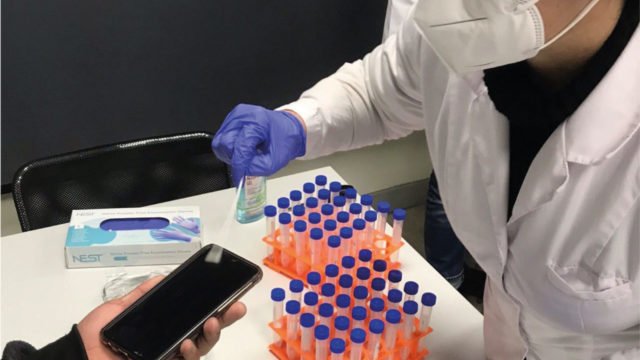Our cell phones say more about ourselves than we think and they could even reveal if we have covid-19, according to a study carried out by Chilean scientists who devised an original method to test the virus: to perform a PCR on the screen of these electronic devices.
It’s called PoST. “Phone screen test” And, according to research published in the English scientific journal eLife, it is a reliable method to identify covid-19 patients, including asymptomatic or presymptomatic patients, since it gives 90% the same result as a nasopharyngeal PCR.
“The most personal device, the cell phone, receives constant exhalation when we speak and digital contact when we touch the screen. It is a true reflection of what we carry inside, “the doctor explained to Efe. Luis Quinones, an academic from the University of Chile, who coordinated the development of the research.
The method was devised by Rodrigo Young, a Chilean biochemist who works at the University College London, in England, and was developed among various institutions, among which the University of Chile and the London Great Ormond Street Hospital stand out.
The main advantage, Young explained to Efe, is that prevents a person from having to go through a nasal swabIt is a non-invasive diagnostic method, and it is also much less expensive than other techniques since it avoids hospital care.
“Taking a human sample is what makes the PCR test more expensive, because what makes it a clinical test, but this method it is much cheaper and could be of great help in tracing and fighting the pandemic“Added the researcher.
“The swab is passed over the cell phone screen instead of the nose and then it is analyzed as with a normal PCR to detect if there are traces of the virus RNA,” academic Alejandra Lavanderos, who participated in the research, explained to EFE.
100% effective in cases of viral load
This testing method is also a good alternative to other less sensitive ones, such as antigen testing, widely used throughout the world, but which, according to the World Health Organization (WHO), has a high risk of false positive results in low prevalence settings.
Young’s team tested around 1,200 people, who underwent both the conventional PCR test and the PoST method, and according to the study, for those who had a high viral load, detection efficiency was 100% with the sample taken from his cell phone.
Meanwhile, for those with a lower viral load, the detection was 80% or higher, and the specificity analysis, aimed at knowing if the surface sample correctly detects negative cases, found that it was 98% effective.

“The good thing about the PoST is that manages to detect the people who are emitting the virus, those who leave it on the screen, who are basically the contagion, those who are keeping the pandemic alive, “Young added.
Useful for detecting variants
Delta, Alhpa or Gamma are several of the SARS-CoV-2 variants that the WHO has added to its list of variants classified as “of concern”, and their traceability has been a challenge worldwide due to their high contagiousness and the logistical difficulties of having to sequence virus samples.
This is why the team of Dr. Quiñones questioned and investigated, with successful results, if the PCR method of the mobile phone screen serves to detect these new variants.
The PoST was shown to be a valid procedure to locate variants such as the Brazilian or South African (the only ones that had appeared up to that point in the research), added the doctor, and is potentially effective against Delta, with which testing will begin in the coming days.
“The idea is that we can create an alternative test useful for public health, and now it will have to follow the steps for the health authorities to validate it,” he concluded.

Introvert. Beer guru. Communicator. Travel fanatic. Web advocate. Certified alcohol geek. Tv buff. Subtly charming internet aficionado.